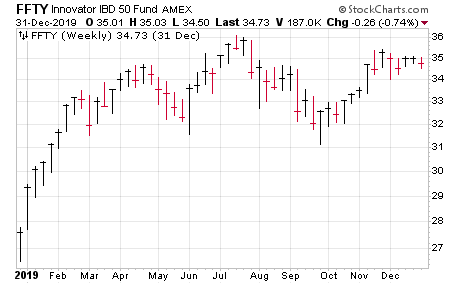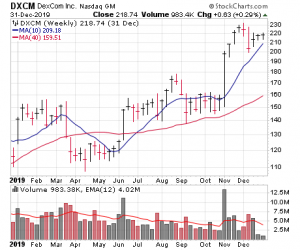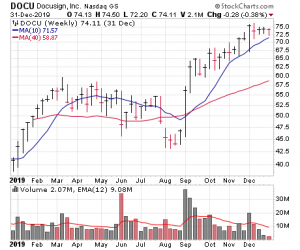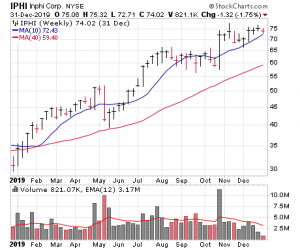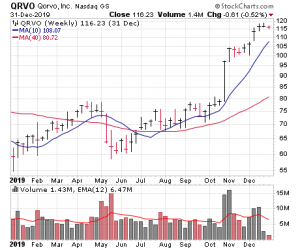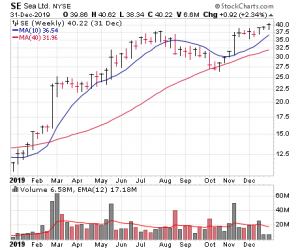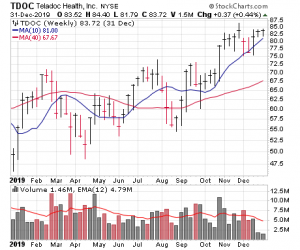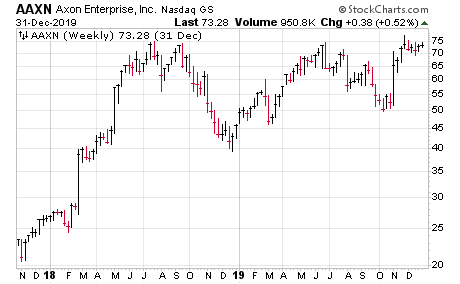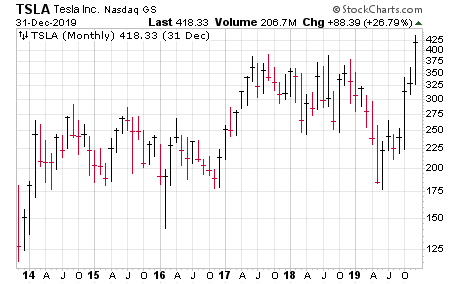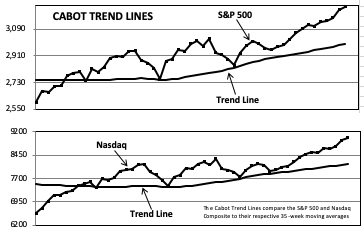It’s a New Year, but the market’s evidence remains unchanged--big picture, it’s a strong bull market, though short-term risks are rising, telling us to be choosy on the buy side and to hold a chunk of cash. That said, we’re still holding on tightly to our winners and think a few of our current stocks can enjoy sustained runs from here.
In tonight’s issue, we write about how many stocks that have recently had big moves actually look to be early in their overall advances; pullbacks, in other words, should offer buying opportunities. We also dive into our stocks and write about a couple of names on our watch list could be our next buys.
Cabot Growth Investor 1436
[premium_html_toc post_id="194290"]
Happy New Year
The calendar has flipped to 2020, but nothing much has changed with the market’s evidence. On a longer-term basis, most primary indicators, such as our Cabot Trend Lines and Cabot Tides, continue to look great, and we’ve written numerous times about a handful of big-pictures studies (such as the monthly MACD on the indexes) that point to higher prices down the road. Plus, we’re pleased that so many stocks have broken out from huge launching pads of one or two years or even longer, which bodes well. (We write a bit about this later this issue.) There are never any sure things, but based on what we see, 2020 is likely to be a bull year.
Short-term, though, the yellow flags that have been with us for a couple of weeks are still hanging around. Several measures suggest greed has picked up (though we wouldn’t say it’s out of control), which, along with the simple fact most indexes and many stocks are extended to the upside, could easily lead to some indigestion and rotation.
Thus, our stance is unchanged—we’re still mostly bullish, and we think a lot of stocks we own are capable of making bigger moves over time, though right now it’s probably best to be choosy on the buy side (don’t avoid the buy side, but pick your spots) and hold a bit of cash (17% in the Model Portfolio), both due to the short-term stuff mentioned above and the fact that early January is often hectic and choppy as big investors reposition their portfolios.
What we’re most interested in watching as 2020 begins, though, isn’t the market as a whole but the action of individual stocks. While we have no complaints about the past couple of months, many growth titles took a breather in December—it would be nice if something like the IBD 50 Fund (FFTY, shown below) took off on the upside. And when it comes to sectors, we’ll be watching to see if some slumbering areas (like cloud software) re-emerge.
What to Do Now
As always, though, we’ll go with the flow and listen to the market’s message. Right now, that tells us to be bullish and to give our top performers a chance to grow into larger winners. We have no changes in the Model Portfolio tonight, though there are a couple of names on our watch list that we’re very high on, especially if we see some market-induced pullbacks in the days ahead.
Model Portfolio Update
The market’s outlook hasn’t changed much during the past couple of weeks (longer-term, it’s definitely a bull market, though shorter-term, the odds favor some trickier trading going forward) so our portfolio hasn’t changed much, either. We’re still mostly invested, but holding a chunk of cash (17%) as we look for (a) some steam to come off the market and/or (b) some stocks we’re eyeing to offer entry points.
All in all, we’re generally happy with our current crop of stocks, and as we’ve written before, think we own some of the leaders of this move. But we’re not complacent, either. A handful of our names have done more consolidating than advancing during the past few weeks, and if they can’t shape up during the next two or three weeks, we could ship them out.
That said, right now, we’re content to observe how things go—January is often a tricky month, and letting things settle out for a bit is usually the right thing to do. We have no changes tonight.
Current Recommendations
Dexcom (DXCM 219)—DXCM has generally steadied itself following its short, sharp plunge three weeks ago. The question in our mind is whether there will be another leg down (possibly a retest of the lows near 200), especially if the market or medical stocks (which were lower today) hit a pothole. That wouldn’t be fun, but we continue to keep our eye on the big picture: Not only is the firm’s G6 continuous glucose monitor selling well and being integrated into more pumps (like Tandem’s) and personalized systems (like Lily’s), but the firm’s next-generation G7 (limited launch in the latter part of 2020) should expand Dexcom’s target market to non-invasive Type II diabetics. Moreover, the shift to sales through the pharmacy channel has been a huge success, attracting tons of new customers thanks to lower upfront costs. The firm is presenting at a popular healthcare conference in early January (likely presenting the week after next), and as to any 2020 guidance, Dexcom usually guides low and then trashes estimates (last year it guided for 17% revenue growth—but the real figure likely ended up near 40%!). All in all, we remain optimistic DXCM is a liquid leader that will head higher over time. BUY.
DocuSign (DOCU 76)—DOCU hasn’t been the strongest growth stock during the past couple of months, with a stair-step advance that’s ridden the 10-week line higher. That said, after some initial post-earnings wobbles, the stock tightened up for the past three weeks and today it popped to new highs, which is always a good thing. Nothing has changed with the story here, which remains as big as it gets; there seems to be little stopping DocuSign from capturing a growing share of the e-signature and contract lifecycle market as firms big and small modernize their systems of agreement (and pay DocuSign recurring subscription fees for the privilege). A drop back into the upper 60s could have us going to Hold, but given the constructive action of late, we’re fine grabbing some shares here or on dips of a point or two. BUY.
Inphi (IPHI 76)—IPHI hasn’t done a ton (net-net) since its great earnings gap back in late October, but we see encouraging tea leaves on the chart—eight of the past nine completed weeks have closed up and the stock has etched a reasonable seven-week consolidation. One worry is that the chip sector in general has been strong, so if the group corrects it could weigh on the stock. But IPHI isn’t so directly tied to chip stocks (it’s more on the networking side of things), and all indications are that the company as begun what should be a very strong growth phase for the next couple of years. Similar to DOCU, a drop a few points (say, into the 66 to 67 area) could have us switching to a Hold rating, but the evidence continues to say that the buyers are in control. BUY.
ProShares Ultra S&P 500 Fund (SSO 154)—We don’t have any grand new thoughts when it comes to the overall market (long-term bullish, short-term coin flip), so we won’t rehash that here. If the market does pull back, it’s likely any dip toward the 10-week line (now nearing 144) would find support—and if that area happened to fail, there should be great support not too far below that. Bigger picture, SSO followed the S&P 500’s lead by going nowhere from January 2018 to early October 2019 and has since rallied about 22% (translating to about 11% on the S&P), which looks to us like a kickoff of a sustained rally. If you want to book a little partial profit due to the short-term risks, that’s fine, but we’re sticking with our good-sized position for now in an attempt to ride out the potentially longer-term upmove. BUY.
Qorvo (QRVO 116)—QRVO is our favorite among a handful of semiconductor stocks that look set to earn huge money during the next two to three years as 5G smartphones and Internet of Things devices hit the mainstream. After no growth during the past two years, one analyst sees total radio frequency (RF) component sales growing at a 14% annual pace through 2022, with 5G RF sales exploding from just $250 million last year to $11 billion in 2022! Moreover, one fact playing in Qorvo’s favor is the preference of device makers for integrated solutions (instead of one-off components that usually offer less performance); it’s likely the company will outperform current conservative market share guesstimates by Wall Street. As for the stock, it’s certainly earned the right to consolidate for a bit if it wants to (the 50-day line is down around 103 and rising quickly), but we’re thinking the massive multi-year breakout in November and big growth story mean higher prices are coming down the road. We’ll stay on Buy, though you might consider keeping new buys on the small side or looking for pullbacks of two or three points. BUY.
Sea Ltd. (SE 40)—SE is off to a decent start for us—it looks like the stock wants to head higher if the market and sector (Asian e-commerce plays) allow it. The big driver of investor perception going forward should be the firm’s Shopee e-commerce division, which has the potential to boom for many years, though we also think Sea’s online entertainment division (bolstered in part by its popular Free Fire game) could surprise on the upside as it did for much of 2019. If the stock pushes up another couple of points, we could average up, but for now we’ll stick with our half-sized position. BUY A HALF.
Teladoc (TDOC 83)—TDOC has been up and down for the past five weeks, but like many other growth names that have consolidated, this looks like a normal rest period, with volume buying at the “right” spot (near the 50-day line two weeks ago) and some tightness since. Throw in plenty of positive fundamental tidbits from the past couple of months (management is comfortable with a 20% to 30% organic growth target; bookings up 30% as of late 2019; newer offerings like behavioral health are seeing a 50%-plus gain in visit volumes) and the odds favor the next big move being up. A drop toward its December lows (76 to 77 area) would be iffy, but we’re sticking with our Buy rating right here; if you don’t own any, pick up some shares here. BUY.
Vertex Pharmaceuticals (VRTX 219)—Similar to a handful of other stocks, VRTX has marked time for about a month, but we think it’s gathering strength for its next upmove; the tight trading range with next-to-no giveback following a big October-November move smells like institutional accumulation. Of course, there are no sure things, and a dive back toward the 200 level would be borderline abnormal, but it’s much more likely that (a) most weak hands are already out of the stock given VRTX’s prior two years of choppy action and no net progress, and that (b) big investors want a (bigger) piece of what should be an explosive growth story. A short-term shakeout of a few points wouldn’t shock us, but we’re OK picking up shares here if you don’t own any. BUY.
Watch List
- Axon Enterprise (AAXN 77): AAXN has a nice-looking setup to an 18-month base, along with a fundamental story that’s easy to love. Now we’re looking for a decisive breakout. See more later in this issue.
- Floor & Décor (FND 51): Some retail names have come to life, and we think FND could be set to emerge as construction areas of the economy pick up steam.
- Luckin Coffee (LK 38): Recent IPOs can often turn tail quickly, but right now LK is one of the leading glamour stocks in the market thanks to its mind-boggling growth.
- Splunk (SPLK 152): The software sector might be getting its act together, and Splunk looks like one of the leaders, with an early-stage breakout and terrific growth as it solidifies its position in Big Data.
- Tesla (TSLA 430): TSLA has exploded to new highs and is probably due for a rest, but we think the big recent run is the start of a new, sustained uptrend. See more later in this issue.
Other Stocks of Interest
Axon Enterprise (AAXN 77)—Patience is a virtue in the stock market in two ways. First, it allows winners time to keep growing and really make a difference in your portfolio, and second, it allows you to wait for lower-risk entry points. That’s what we’ve been doing with Axon Enterprise, which came to life in early November (we wrote it up on this page six weeks ago) after a great earnings report that revealed further progress in its business transition from a one-off seller of electric weapons (stun guns) to a recurring revenue-based provider of video evidence management systems (much of which is recorded via its body cameras and in-car video systems). And the good news has continued since, with Australia’s federal police ordering a slew of Axon’s products and correction centers in New South Wales planning to do the same. (Annualized recurring revenue rose 39% in Q3, while total future contracted revenue was up was up 38% to $1.13 billion.) However, the stock stalled out right at its prior highs in the mid 70s, so we’ve been waiting patiently, but now AAXN appears to be gathering strength for a decisive move higher; shares have consolidated in a relatively tight range for about five weeks on light volume, and despite some market-wide wobbles this week, it’s pushed back toward its peaks. Shares are still fidgety and thinly traded, but we like the year-and-a-half long launching pad, the recent tightness and the potential of firm’s new, more predictable business model (analysts see earnings up 25% in 2020). A decisive breakout would be tempting; AAXN remains on our watch list.
WPX Energy (WPX 14)—We’re growth investors first and foremost, but we’re also students of the market, which means we keep our eyes open for unusual opportunities that may arise. And we think there’s a chance (just a chance) that some energy stocks, which have been awful performers for years (the sector dipped below its 2016 low in December!), could surprise on the upside. One name to watch is WPX Energy, an explorer with top-notch acreage in the Williston (North Dakota mainly) and Delaware (within the larger Permian) basins that’s been executing very well. Not only has growth been solid (oil volumes up a whopping 30% in Q3), but the firm has emphasized low-cost wells (average payback just 14 months for some wells!) that has resulted in declining debt (no maturities until 2023), growing free cash flow and even share buybacks. That’s all to the good, but the real catalyst appears to be a well-timed acquisition announced last month: WPX is buying Delaware basin operator Felix Energy for $2.5 billion (including $900 million in cash) in a deal that will be accretive to all key metrics (WPX paid less than half the price of recent Permian deals on a per-acre basis!) and bring along 1,500 undeveloped drilling locations. At $55 oil, management now sees $350 million of free cash flow next year, it plans to start a token dividend when the transaction closes and the firm has oodles of high-margin drilling possibilities should energy prices pick up. As for the stock, it fell hard late last year and couldn’t get off its knees in 2019, but it did form a multi-month bottom in the 9 area and has since launched to its highest level since May. If the energy sector makes a move, WPX looks like a winner.
10x Genomics (TXG 73)—There are big ideas and then there are big ideas, and 10x Genomics has about as big an idea as there is. In a very broad nutshell, the company has the potential be the Illumina of the next wave of the genomics revolution: Its Chromium platform allows researchers to measure and test things on a single-cell basis and to do so at scale, while its recently-launched Visium platform allows them to better see how cells and molecules are arranged in certain tissues. All told, 10x’s products allow clients to better understand the inner workings of biological systems, and they’ve been a hit; more than 570 papers regarding various discoveries have been published by customers using these platforms, and more than 90% of the top research institutions (and most top pharmaceutical firms) use at least one of them. There is some competition and some legal risk (10x just lost a lawsuit with Bio-Rad, though the damages were less than expected), but the big-picture upside potential is huge if 10x can continue to innovate and collect ever-increasing streams of recurring revenue. (The average Chromium system uses around $150,000 of consumables per year!) The stock is wild, crazy and thinly traded, but already 234 mutual funds have bought a position (including a few top performing outfits), and TXG enjoyed some excellent volume clues in December. It’s too thin for us right now, but it’s one to at least keep an eye on.
Romance, Transition, Reality
There are more than a few stocks that have taken off on the upside in recent weeks, so much so that it’s caused many investors to snap their fingers and declare, “I missed it!” But in many cases, the stocks that have had huge runs only recently got going from massive consolidations (one to two years, sometimes longer), similar to the overall market—and that action implies that the overall moves are still in the early stages.
Plus, some of these situations play into one of our favorite constructs for stock action: Romance, Transition and Reality. The Romance phase (there can be a couple of them during a stock’s heyday) is when a stock is bid up over many months or years based mostly on promise. Yes, the firm is doing well and has products on the market, but the valuation is sky-high as investors discount an ever-rosier future. Many analysts are just beginning to cover the company during this time.
Then comes the Transition phase, which can last anywhere from a few months to a few years. During this time, the hopes and dreams of the Romance phase slowly fade as valuations come back to earth and the stock is subject to more scrutiny (and short selling) among big investors.
Then, finally, comes the Reality phase; great gains can still be made here, but progress tends to be more “normal” than in the Romance phase, with buying (and selling) based mostly on real results. At this point, there are usually a couple dozen analysts following the firm’s every move, with new product launches and earnings reports driving investor perception.
The good news is that, partially due to the market’s overall action (no net progress for 20 months before the October breakout), we’re seeing more than a few stocks following the Romance-Transition-Reality pattern.
A name that still needs work is Square (SQ), which was one of the bigger winners of the 2017-2018 bull market, rallying fivefold during that time as the firm staked its claim at being the next big thing in the payments field. But the past 15 months (Transition phase) have seen the stock languish as growth has slowed a bit and the valuation comes down to earth. We certainly wouldn’t get involved here (the stock isn’t in a longer-term uptrend), but there’s been some encouraging option activity and the fundamentals continue to improve (sales and earnings should both grow mid 20% range in 2020). A move above 85 or so could signal the start of a Reality phase.
The next is a stock we wrote up earlier in this issue: Axon Enterprise (AAXN), which came to life in February 2018 as investors first began to enthuse about the firm’s new recurring revenue-heavy business model. After topping in the summer of last year, the Transition phase has now gone on for nearly a year and a half, but there are signs that the Reality phase could be underway—shares popped after Q3 earnings and are tightening up just south of multi-year highs. (See Other Stocks of Interest for more.)
And the third name is Tesla (TSLA), which by all accounts has already entered its Reality phase. In this case, the Transition phase lasted much longer than the two stocks mentioned above—TSLA peaked back in early 2017, and it made no net progress from early 2014 through October of this year! (Monthly chart is shown below.)
Now, though, big investors are thinking the firm has finally turned the corner; demand has never been an issue, with the company selling as many Model 3’s it can produce, and preliminary orders for the cybertruck look promising. But what really has investors picking up shares are the opening of new markets (deliveries have begun in China) along with real profits; analysts see sales up 22% this year with earnings booming to $5.45 per share.
Shares have had a huge run in recent months, decisively lifting to new all-time highs. TSLA probably needs time to digest, but instead of thinking that we missed the boat, the odds are better that the stock is still early in a new, sustained upmove. A couple of weeks of pullback and consolidation could offer up a solid entry point. WATCH.
Cabot Market Timing Indicators
The market remains in a strong uptrend, and many primary (trend, action of leading stocks) and other (longer-term studies) indicators telling us that the bull market has a ways to run. Short-term, though, the risk of a trickier environment during the next few weeks is growing as the indexes are stretched to the upside.
Cabot Trend Lines: Bullish
Our Cabot Trend Lines remain solidly bullish as 2020 begins, with both the S&P 500 (by 8.4%) and Nasdaq (up 10.4%) miles above their respective 35-week moving averages. With the indexes so stretched above their longer-term moving averages, the odds of some sort of pause or correction are growing—but even if that occurs, higher prices are likely in the months ahead.
Cabot Tides: Bullish
Our Cabot Tides also remain positive, with all five indexes we track (including the S&P 400 MidCap, shown here) holding well above their lower (50-day), rising moving averages. Of course, a pullback is overdue, but right now a retreat of 3% or so could be tolerated without altering the intermediate-term uptrend. With both the Trend Lines and Tides pointed up, you should keep your optimist’s hat on.
Cabot Real Money Index: Positive
Our Real Money Index is actually in positive territory, though that’s mostly because of the normal seasonal outflows that occurred last month (December almost always sees outflows). Thus, we’re not reading this as a short-term positive, though the continued lack of meaningful inflows suggests many investors remain on the sideline—a big-picture plus.
Charts courtesy of StockCharts.com
The next Cabot Growth Investor issue will be published on January 16, 2020.
Cabot Wealth Network
Publishing independent investment advice since 1970.
CEO & Chief Investment Strategist: Timothy Lutts
President & Publisher: Ed Coburn
176 North Street, PO Box 2049, Salem, MA 01970 USA
800-326-8826 | support@cabotwealth.com | CabotWealth.com
Copyright © 2020. All rights reserved. Copying or electronic transmission of this information is a violation of copyright law. For the protection of our subscribers, copyright violations will result in immediate termination of all subscriptions without refund. No Conflicts: Cabot Wealth Network exists to serve you, our readers. We derive 100% of our revenue, or close to it, from selling subscriptions to its publications. Neither Cabot Wealth Network nor our employees are compensated in any way by the companies whose stocks we recommend or providers of associated financial services. Disclaimer: Sources of information are believed to be reliable but they are not guaranteed to be complete or error-free. Recommendations, opinions or suggestions are given with the understanding that subscribers acting on information assume all risks involved. Buy/Sell Recommendations: All recommendations are made in regular issues or email alerts or updates and posted on the private subscriber web page. Performance: The performance of this portfolio is determined using the midpoint of the high and low on the day following the recommendation. Cabot’s policy is to sell any stock that shows a loss of 20% in a bull market or 15% in a bear market from the original purchase price, calculated using the current closing price. Subscribers should apply loss limits based on their own personal purchase prices.

